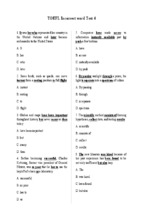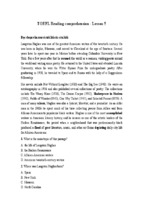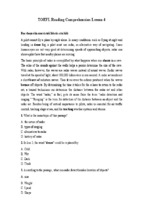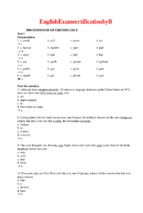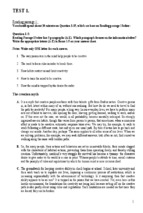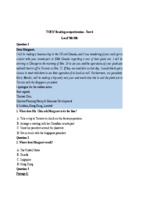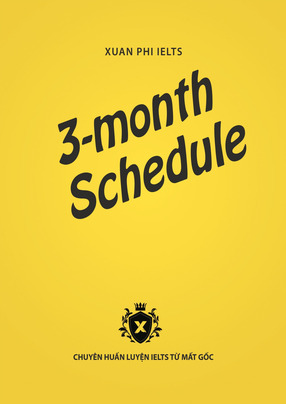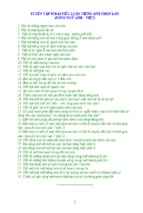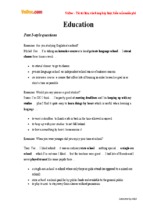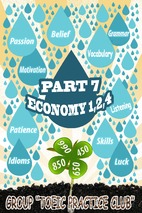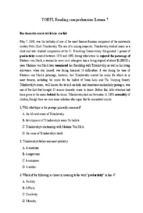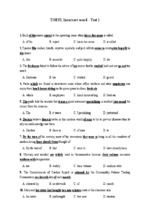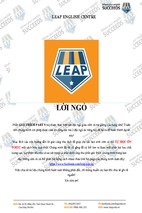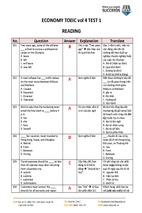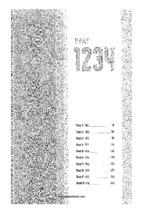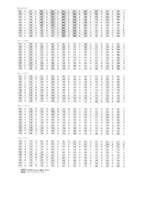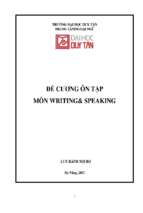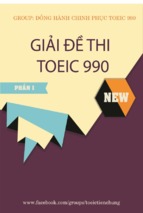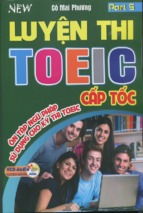Peterson’s
MASTER
TOEFL
VOCABULARY
00_TOEFL Vocab FM,i-x
1
8/9/06, 10:13
About Peterson’s, A Nelnet Company
Peterson’s (www.petersons.com) is a leading provider of education information and advice, with books and
online resources focusing on education search, test preparation, and financial aid. Its Web site offers searchable
databases and interactive tools for contacting educational institutions, online practice tests and instruction, and
planning tools for securing financial aid. Peterson’s serves 110 million education consumers annually.
For more information, contact Peterson’s, A Nelnet Company, 2000 Lenox Drive, Lawrenceville, NJ 08648; 800338-3282; or find us on the World Wide Web at: www.petersons.com/about
Portions of this book were previously published in Reading and Vocabulary Workbook for the TOEFL Exam
and Ultimate Word Success.
© 2006 by Elizabeth Davy and Karen Davy
TOEFL is a registered trademark of Educational Testing Service (ETS). This book is not endorsed or
approved by ETS.
Editor: Wallie Walker Hammond; Manufacturing Manager: Ray Golaszewski
ALL RIGHTS RESERVED. No part of this work covered by the copyright herein may be reproduced or used
in any form or by any means—graphic, electronic, or mechanical, including photocopying, recording, taping,
Web distribution, or information storage and retrieval systems—without the prior written permission of the
publisher.
ISBN-13: 978-0-7689-2328-5
ISBN-10: 0-7689-2328-X
Printed in the United States of America
10 9 8 7 6 5 4 3 2 1 08 07 06
First Edition
00_TOEFL Vocab FM,i-x
2
8/9/06, 10:13
Petersons.com/publishing
Check out our Web site at www.petersons.com/publishing to see if there is any new information
regarding the test and any revisions or corrections to the content of this book. We’ve made sure
the information in this book is accurate and up-to-date; however, the test format or content may
have changed since the time of publication.
00_TOEFL Vocab FM,i-x
3
8/9/06, 10:13
OTHER TITLES IN SERIES:
Peterson’s Master TOEFL Reading
Peterson’s Master TOEFL Writing Skills
00_TOEFL Vocab FM,i-x
4
8/9/06, 10:13
Contents
○
○
○
○
○
○
○
○
○
○
○
○
○
○
○
○
○
○
○
○
○
○
○
○
○
○
○
○
○
○
○
○
○
○
○
○
○
○
○
○
○
○
○
○
○
○
Before You Begin . . . . . . . . . . . . . . . . . . . . . . . . . . . . . . . . . . . . . . . . . vii
How This Book Is Organized . . . . . . . . . . . . . . . . . . . . . . . . . . . . . . . . . vii
Special Study Features . . . . . . . . . . . . . . . . . . . . . . . . . . . . . . . . . . . . . . vii
You’re Well on Your Way to Success . . . . . . . . . . . . . . . . . . . . . . . . . . . viii
Give Us Your Feedback . . . . . . . . . . . . . . . . . . . . . . . . . . . . . . . . . . . . . viii
Top 10 Strategies to Raise Your Score . . . . . . . . . . . . . . . . . . . . . . . . . . . ix
PART I: TOEFL VOCABULARY BASICS
1
All About TOEFL Vocabulary . . . . . . . . . . . . . . . . . . . . . . . . . . . . . 3
Vocabulary on the TOEFL . . . . . . . . . . . . . . . . . . . . . . . . . . . . . . . . . . . . 3
Strategies for Learning and Remembering New Words . . . . . . . . . . . . . 3
Summing It Up . . . . . . . . . . . . . . . . . . . . . . . . . . . . . . . . . . . . . . . . . . . . 18
PART II: DIAGNOSING STRENGTHS AND WEAKNESSES
2
Practice Test 1: Diagnostic . . . . . . . . . . . . . . . . . . . . . . . . . . . . . 23
Answer Key and Explanations . . . . . . . . . . . . . . . . . . . . . . . . . . . . . . . . 25
PART III: TOEFL VOCABULARY REVIEW
3
Words in Context . . . . . . . . . . . . . . . . . . . . . . . . . . . . . . . . . . . . . 29
Strategies for Defining Words from Context . . . . . . . . . . . . . . . . . . . . . 29
Exercises . . . . . . . . . . . . . . . . . . . . . . . . . . . . . . . . . . . . . . . . . . . . . . . . . 50
Answer Key . . . . . . . . . . . . . . . . . . . . . . . . . . . . . . . . . . . . . . . . . . . . . . . 57
Summing It Up . . . . . . . . . . . . . . . . . . . . . . . . . . . . . . . . . . . . . . . . . . . . 59
4
Everyday and Specific Vocabulary . . . . . . . . . . . . . . . . . . . . . 61
Strategies for Learning Related Words . . . . . . . . . . . . . . . . . . . . . . . . . 61
How Thoughts Are Related . . . . . . . . . . . . . . . . . . . . . . . . . . . . . . . . . . . 61
Exercises . . . . . . . . . . . . . . . . . . . . . . . . . . . . . . . . . . . . . . . . . . . . . . . . . 86
Answer Key . . . . . . . . . . . . . . . . . . . . . . . . . . . . . . . . . . . . . . . . . . . . . . . 90
Summing It Up . . . . . . . . . . . . . . . . . . . . . . . . . . . . . . . . . . . . . . . . . . . . 91
5
All About Roots . . . . . . . . . . . . . . . . . . . . . . . . . . . . . . . . . . . . . . 93
Word Roots . . . . . . . . . . . . . . . . . . . . . . . . . . . . . . . . . . . . . . . . . . . . . . . 93
Strategies for Learning Roots . . . . . . . . . . . . . . . . . . . . . . . . . . . . . . . . 93
How Roots Work . . . . . . . . . . . . . . . . . . . . . . . . . . . . . . . . . . . . . . . . . . . 94
v
00_TOEFL Vocab FM,i-x
5
8/9/06, 10:13
○
○
○
○
○
○
○
○
○
○
○
○
○
○
○
○
○
○
○
○
○
○
○
○
○
vi
○
○
○
○
○
○
Contents
○
○
○
○
○
○
○
○
○
○
○
○
○
○
○
○
○
○
○
○
○
○
○
○
○
○
○
○
○
○
○
○
○
○
○
○
○
○
○
○
○
○
○
○
○
○
○
○
○
○
○
○
○
○
○
○
○
○
Learning Words with Greek Roots . . . . . . . . . . . . . . . . . . . . . . . . . . . . . 97
○
○
Learning Words with Latin Roots . . . . . . . . . . . . . . . . . . . . . . . . . . . . 101
○
○
Exercises . . . . . . . . . . . . . . . . . . . . . . . . . . . . . . . . . . . . . . . . . . . . . . . . 110
○
○
Answer Key . . . . . . . . . . . . . . . . . . . . . . . . . . . . . . . . . . . . . . . . . . . . . . 114
6
All About Prefixes . . . . . . . . . . . . . . . . . . . . . . . . . . . . . . . . . . . 117
○
○
○
○
○
○
Summing It Up . . . . . . . . . . . . . . . . . . . . . . . . . . . . . . . . . . . . . . . . . . . 115
○
○
Prefixes . . . . . . . . . . . . . . . . . . . . . . . . . . . . . . . . . . . . . . . . . . . . . . . . . 117
○
○
Strategies for Learning Prefixes . . . . . . . . . . . . . . . . . . . . . . . . . . . . . 117
○
○
How Prefixes Work . . . . . . . . . . . . . . . . . . . . . . . . . . . . . . . . . . . . . . . . 118
○
○
Learning Words with Greek Prefixes . . . . . . . . . . . . . . . . . . . . . . . . . . 121
○
○
Learning Words with Latin Prefixes . . . . . . . . . . . . . . . . . . . . . . . . . . 127
○
○
Prefixes for Numbers . . . . . . . . . . . . . . . . . . . . . . . . . . . . . . . . . . . . . . 133
○
○
Anglo-Saxon Prefixes . . . . . . . . . . . . . . . . . . . . . . . . . . . . . . . . . . . . . . 133
○
○
Exercises . . . . . . . . . . . . . . . . . . . . . . . . . . . . . . . . . . . . . . . . . . . . . . . . 135
○
○
Answer Key . . . . . . . . . . . . . . . . . . . . . . . . . . . . . . . . . . . . . . . . . . . . . . 140
7
All About Suffixes . . . . . . . . . . . . . . . . . . . . . . . . . . . . . . . . . . . . 143
Suffixes . . . . . . . . . . . . . . . . . . . . . . . . . . . . . . . . . . . . . . . . . . . . . . . . . 143
Strategies for Learning Suffixes . . . . . . . . . . . . . . . . . . . . . . . . . . . . . 143
How Suffixes Work . . . . . . . . . . . . . . . . . . . . . . . . . . . . . . . . . . . . . . . . 144
Suffixes That Describe State of Being . . . . . . . . . . . . . . . . . . . . . . . . . 148
Suffixes That Indicate Occupations . . . . . . . . . . . . . . . . . . . . . . . . . . . 150
Suffixes That Show Resemblance . . . . . . . . . . . . . . . . . . . . . . . . . . . . 152
Suffixes That Show Amount . . . . . . . . . . . . . . . . . . . . . . . . . . . . . . . . . 155
Twelve Useful Suffixes . . . . . . . . . . . . . . . . . . . . . . . . . . . . . . . . . . . . . 155
Exercises . . . . . . . . . . . . . . . . . . . . . . . . . . . . . . . . . . . . . . . . . . . . . . . . 159
Answer Key . . . . . . . . . . . . . . . . . . . . . . . . . . . . . . . . . . . . . . . . . . . . . . 164
Summing It Up . . . . . . . . . . . . . . . . . . . . . . . . . . . . . . . . . . . . . . . . . . . 166
PART IV: TWO PRACTICE TESTS
Practice Test 2 . . . . . . . . . . . . . . . . . . . . . . . . . . . . . . . . . . . . . . 171
Answer Key and Explanations . . . . . . . . . . . . . . . . . . . . . . . . . . . . . . . 176
Practice Test 3 . . . . . . . . . . . . . . . . . . . . . . . . . . . . . . . . . . . . . . 181
Answer Key and Explanations . . . . . . . . . . . . . . . . . . . . . . . . . . . . . . . 186
www.petersons.com
○
○
○
○
○
○
○
○
○
○
○
○
○
○
○
○
○
○
○
○
○
○
○
○
○
○
○
○
○
○
○
○
○
○
○
○
○
○
○
○
○
○
○
○
○
○
○
○
○
○
○
○
○
○
○
○
Summing It Up . . . . . . . . . . . . . . . . . . . . . . . . . . . . . . . . . . . . . . . . . . . 142
○
6
○
00_TOEFL Vocab FM,i-x
8/9/06, 10:13
○
○
○
○
Before You Begin
○
○
○
○
○
○
○
○
○
○
○
○
○
○
○
○
○
○
○
○
○
○
○
○
○
○
○
○
○
○
○
○
○
○
○
○
○
○
○
○
○
○
○
○
○
○
HOW THIS BOOK IS ORGANIZED
If you are preparing for any version of the TOEFL, you are not alone. Almost a
million people all over the world took the TOEFL last year. A high score on this
test is an essential step in being admitted to undergraduate or graduate
programs at almost all colleges and universities in North America. But preparing for this test can be a difficult, often frustrating, experience.
Peterson’s Master TOEFL Vocabulary, used as a self-tutor, will help you improve
your vocabulary skills. You’ll learn many of the “right” words—words you don’t
already know but that are likely to appear on your test.
•
•
Top 10 Strategies to Raise Your Score gives you test-taking strategies.
•
Part II provides a diagnostic test to determine your strengths and weaknesses.
•
Part III provides the basic vocabulary review. The words you’ll encounter
start with those that are relatively simple. They become relatively difficult
as you continue through the book. Various learning strategies, such as
learning root words, are reviewed.
•
Part IV consists of two additional practice vocabulary tests. They will show
you how well you have mastered the vocabulary skills presented in this book.
Part I provides TOEFL vocabulary basics, including strategies for learning
and remembering new words.
SPECIAL STUDY FEATURES
Peterson’s Master TOEFL Vocabulary is designed to be user-friendly. To this
end, it includes features to make your preparation much more efficient.
Overview
The review chapters begin with a bulleted overview, listing the topics to be
covered in the chapter. This will allow you to quickly target the areas in which
you are most interested.
vii
00_TOEFL Vocab FM,i-x
7
8/9/06, 10:13
○
○
○
○
○
○
○
○
○
○
○
○
○
○
○
○
○
○
○
○
○
○
○
○
○
viii
○
○
○
○
○
○
Before You Begin
○
○
○
○
○
○
○
○
○
○
○
○
○
○
○
○
○
○
○
○
○
○
○
○
○
○
○
○
○
○
○
○
○
○
○
○
○
○
○
○
○
○
○
○
○
○
○
○
○
○
○
○
○
○
○
○
Bonus Information
As you work your way through the book, keep your eyes on the margins to find the following:
NOTE
Notes highlight critical information about improving your vocabulary.
TIP
Tips draw your attention to valuable concepts, advice, and shortcuts for tackling the
harder vocabulary words.
Summing It Up
The review chapter ends with a point-by-point summary that captures the most
important concepts. They are a convenient way to review the chapter’s key points.
Practice Tests
The three practice tests, including the diagnostic test, are designed to help you prepare
with little anxiety.
YOU’RE WELL ON YOUR WAY TO SUCCESS
The TOEFL tests your vocabulary with “vocabulary-in-context” questions in which you
must determine the meaning of words as used in a specific sentence, as well as indirectly
through the use of reading comprehension passages and questions. The more words you
know, the better your chances of narrowing down the choices to the correct one.
Peterson’s Master TOEFL Vocabulary will help you to fine tune your vocabulary skills.
GIVE US YOUR FEEDBACK
Peterson’s publishes a full line of resources to help guide international students through
the college admission process.
We welcome any comments or suggestions you may have about this publication and
invite you to complete our online survey at www.petersons.com/booksurvey. Or you can
fill out the survey at the back of this book, tear it out, and mail it to us at:
○
○
○
○
○
○
○
○
○
○
○
○
○
○
○
○
○
○
○
○
○
○
○
○
○
○
○
○
○
○
○
○
○
○
○
○
○
○
○
○
○
○
○
○
○
○
○
○
○
○
○
○
○
○
○
○
○
○
○
○
○
○
○
○
○
○
○
○
○
○
Your feedback will help us to provide personalized solutions for your educational
advancement.
www.petersons.com
○
○
○
○
○
○
○
○
○
○
○
○
○
○
○
○
○
○
○
○
○
○
Publishing Department
Peterson’s
2000 Lenox Drive
Lawrenceville, NJ 08648
○
8
○
00_TOEFL Vocab FM,i-x
8/9/06, 10:13
Before You Begin
○
○
○
○
○
○
○
○
○
○
○
○
○
○
○
○
○
○
○
○
○
○
○
○
○
○
○
○
○
○
○
ix
○
○
○
○
○
○
○
○
○
○
○
○
○
○
○
○
○
○
○
○
○
○
○
○
○
TOP 10 STRATEGIES TO RAISE YOUR SCORE
1.
As with other sections of the TOEFL, be familiar with the directions and examples
so you can begin work immediately.
2.
For each passage, begin by briefly looking over the questions (but not the answer
choices). Try to keep these questions in mind during your reading.
3.
Scan passages to find and highlight the important facts and information.
4.
Read each passage at a comfortable speed.
5.
Answer the questions, referring to the passage when necessary.
6.
Eliminate answers that are clearly wrong or do not answer the question. If more
than one option remains, guess.
7.
Mark difficult or time-consuming answers so that you can come back to them later
if you have time.
8.
Timing is an important factor. Don't spend more than 10 minutes on any one reading
and the questions about it.
9.
Concentration is another important factor. The reading section is one of the longer
sections of the test. Your practice and hard work will help you.
10. Relax the night before the exam.
www.petersons.com
00_TOEFL Vocab FM,i-x
9
8/9/06, 10:13
○
○
○
○
○
○
○
00_TOEFL Vocab FM,i-x
10
8/9/06, 10:13
PART I
○
○
○
○
○
○
○
○
○
○
○
○
○
○
○
○
○
○
○
○
○
○
○
○
○
○
○
○
○
○
○
○
○
○
○
○
○
○
○
○
○
○
○
○
○
○
○
○
○
○
○
○
○
○
TOEFL VOCABULARY
BASICS
○
○
○
○
○
○
○
○
○
○
○
○
○
○
○
○
○
○
○
○
○
○
○
○
○
○
○
○
○
○
○
○
○
CHAPTER 1
01_TOEFL Vocab,Ch1,1-18
1
○
○
○
○
○
○
○
○
○
○
○
○
○
○
○
○
○
○
○
○
○
○
○
○
○
○
○
○
○
All About TOEFL Vocabulary
8/4/06, 12:28
○
○
○
○
○
○
○
○
○
○
○
01_TOEFL Vocab,Ch1,1-18
2
8/4/06, 12:28
All About TOEFL
Vocabulary
○
○
○
○
○
○
○
○
○
○
○
○
○
○
○
○
○
○
○
○
○
○
○
○
○
○
○
○
○
○
○
○
○
○
○
○
○
○
○
○
○
○
○
○
○
○
• Vocabulary on the TOEFL
• Strategies for learning and remembering new words
• Summing it up
VOCABULARY ON THE TOEFL
TOEFL vobabulary questions ask you to identify the meanings of words and phrases
that appear in the reading passages. The words and phrases that are tested are
important to understanding the entire passage, and, for the most part, you will have
to figure out their meanings. On the TOEFL iBT, however, if there are technical or
unusual words in the passage, you will see the definition presented in a box.
STRATEGIES FOR LEARNING AND REMEMBERING NEW
WORDS
Read
Reading is probably the single best way to improve your vocabulary. When you’re
preparing for the TOEFL, read materials that contain the words that you are
most likely to encounter.
Use a Dictionary and Thesaurus
If you’re serious about improving your testworthy vocabulary, you must have
(and use!) a good dictionary. (A good thesaurus also helps a lot, but more on that
later.) A dictionary is an alphabetical reference list of the words in the language.
3
01_TOEFL Vocab,Ch1,1-18
3
8/4/06, 12:28
○
○
○
○
○
○
○
○
○
○
○
○
○
○
○
○
○
chapter 1
OVERVIEW
○
○
○
○
○
○
○
○
4
○
○
○
○
○
○
PART I: TOEFL Vocabulary Basics
○
○
○
○
○
○
○
○
○
○
○
○
○
○
○
○
○
○
○
○
○
○
○
○
○
○
○
○
○
○
○
○
○
○
○
○
○
○
○
○
○
○
○
○
○
○
○
○
○
○
○
○
○
○
○
○
A dictionary entry always includes the following components:
•
•
•
•
•
•
Spelling
Pronunciation
Part(s) of speech
Irregular forms of the word
Definition
Etymology (the derivation and development of words)
An entry may also contain synonyms and antonyms of the word; prefixes, suffixes, and
other elements in word formation; and abbreviations.
Most people think that all dictionaries are the same. After all, all dictionaries are chock
full of words listed in alphabetical order. They all have pronunciation guides, word
definitions, and word histories. However, all dictionaries are not the same. Different
types of dictionaries fit different needs.
For example, dictionaries have been written just for scholars who research the history
of language. The most famous scholarly dictionary is The Oxford English Dictionary. An
unabridged dictionary, the OED (as it’s often called) contains more than 500,000
entries. Don’t rush right out to buy one to stash in your bookcase, however, because the
OED now contains about 60 million words in 20 volumes. If shelf space is an issue and
you simply can’t live without an OED, however, online and CD-ROM versions are
available from www.oed.com.
Dictionaries have been created just for adults, college students, high school students,
and elementary school students, too. The following list includes the bestselling general
dictionaries and the Web addresses for the online versions, when available:
•
The American Heritage Dictionary of the English Language (Houghton Mifflin Co.:
www.bartleby.com/61)
•
Merriam-Webster’s Collegiate Dictionary (Merriam-Webster, Inc.: www.m-w.com/
dictionary.htm)
•
•
•
•
Merriam-Webster’s Pocket Dictionary (Merriam-Webster, Inc.)
The New Shorter Oxford English Dictionary (Oxford University Press, Inc.)
The Random House College Dictionary (Random House, Inc.)
Webster’s New World College Dictionary (Hungry Minds, Inc.)
Which dictionary should you purchase and use? Since more than 30,000 dictionaries are
currently offered for sale online, you’ve got some shopping to do. Here’s what you need:
•
A dictionary that contains all the words that you are likely to encounter on
standardized tests. This will most likely be the same dictionary that you can use
in college, in your personal life, and in your professional life.
www.petersons.com
○
○
○
○
○
○
○
○
○
○
○
○
○
○
○
○
○
○
○
○
○
○
○
○
○
○
○
○
○
○
○
○
○
○
○
○
○
○
○
○
○
○
○
○
○
○
○
○
○
○
○
○
○
○
○
○
○
○
○
○
○
○
○
○
○
○
○
○
○
○
○
○
○
○
○
○
○
○
○
○
○
○
○
○
○
○
○
○
○
○
○
○
○
4
○
01_TOEFL Vocab,Ch1,1-18
8/4/06, 12:28
Chapter 1: All About TOEFL Vocabulary
○
○
○
○
○
○
○
○
○
○
○
○
○
○
○
○
○
○
○
○
○
○
○
○
○
○
○
○
○
○
○
○
○
○
○
○
○
5
○
○
○
○
○
○
○
○
○
○
○
○
○
○
○
○
The words explained in terms that you can understand.
•
An online dictionary can’t fulfill all your needs, unless you like to tote around your
laptop and fire it up all the time. Always have a print dictionary to use, even if you
have an online version.
○
○
○
○
○
○
○
○
○
○
○
○
○
○
When you’re trying to find a word in the dictionary, always begin by making an educated
guess as to its spelling. The odds are in your favor. However, the more spelling patterns
you know for a sound, the better your chances of finding the word quickly. You can find
a pronunciation chart in the beginning of any dictionary. Once you’ve narrowed down
your search and you’re flipping through the pages, use the guide words, located on the
upper-corners of the pages, to guide your search. Then, follow strict alphabetical order.
○
○
○
○
○
○
○
○
○
A size that fits your needs. You might wish to buy a hardbound dictionary to use
at home when you study and a smaller paperback to keep in your backpack or
briefcase for immediate reference.
○
○
○
○
•
•
definitions
○
plural
○
part of speech
○
○
○
○
○
○
○
○
○
○
○
○
○
○
○
○
○
etymology
(word history)
○
can-dy (kan’de), n. pl. -dies, v., -died, -dying. —n. 1. any
of a variety of confections made with sugar, syrup, etc.
combined with other ingredients. 2. a single piece of such a
confection. —vt: 3. to cook in sugar or syrup, as sweet
potatoes or carrots. 4. to cook in heavy syrup until transparent, as fruit, fruit peel, or ginger. 5. to reduce (sugar, syrup,
etc.) to a crystalline form, usually by boiling down. vi: to
become candied. see vt. [ME sugre candy candied sugar
< MF sucre candi; candi << Ar qandi or sugar = qand sugar
(< Pers; perh. orig. piece of sugar candy; if so, akin to Skt
khanda piece)]
○
○
○
spelling,
pronunciation
○
○
○
○
The following diagram shows how to read a sample entry.
The part of speech is indicated by the n. It’s an abbreviation for “noun.” Look at the
third entry. The vt: right before the 3. shows that the word can be used as a
transitive verb (a verb that must be followed by a direct object). The vi: at the end
of the fifth entry shows that the word can also be used as an intransitive verb (a verb
that does not need a direct object to make sense in a sentence).
•
The pl. at the beginning of the entry shows how you can make the word plural (more
than one). Here, the singular “candy” becomes the plural “candies.”
○
•
○
Notice the pronunciation comes right after the entry word. It’s in parentheses—
(kan’de).
5
8/4/06, 12:28
○
○
01_TOEFL Vocab,Ch1,1-18
○
○
○
○
○
○
www.petersons.com
○
○
○
○
○
○
○
○
○
○
○
○
○
○
○
○
○
○
○
○
○
○
•
○
○
○
○
Let’s look a little closer at the entry:
○
○
○
○
○
○
○
○
○
○
○
○
○
6
○
○
○
○
○
○
PART I: TOEFL Vocabulary Basics
○
○
○
○
○
○
○
○
○
○
○
○
○
○
○
○
○
○
○
○
○
○
○
○
○
○
○
○
○
○
○
○
○
○
○
○
○
○
○
○
○
○
○
○
○
○
○
○
○
○
○
○
○
○
○
○
•
The definitions follow the plural forms of the word. The word “candy” has several
different meanings. They are arranged by the part of speech: the first definitions
show what “candy” means when used as a noun; the second group shows what
“candy” means when used as a verb.
•
The information at the very end of the entry is the etymology or history of the word.
This shows how the word was formed and came into English.
A thesaurus is a reference book that contains synonyms and antonyms. The word
thesaurus comes from a Greek word that means “collection” or “treasure.” A thesaurus
is especially helpful when you’re trying to express an idea but you don’t know how to
phrase it. It is also a helpful reference book when you are trying to find a better word
than the one you’ve been using. This helps you state exact shades of meaning rather
than approximations. As a result, your vocabulary increases by heaps and heaps of
words. This is clearly a big advantage when it comes to preparing for a standardized
test.
In a thesaurus, words with similar meanings are grouped together. To find a synonym
for a word in a traditional print thesaurus, you must use the index at the back of the
book. However, new editions and online versions of a thesaurus are arranged like a
dictionary in alphabetical order.
If you look up the word exciting in a print thesaurus, you would find this entry:
excitement [n] enthusiasm; incitement
action, activity, ado, adventure, agitation, animation, bother,
buzz*, commotion, confusion, discomposure, disturbance, dither*,
drama, elation, emotion, excitation, feeling, ferment, fever, flurry,
frenzy, furor, fuss, heat*, hubbub*, hullabaloo, hurry, hysteria,
impulse, instigation, intoxication, kicks*, melodrama, motivation, motive, movement, passion, perturbation, provocation, rage,
stimulation, stimulus, stir, thrill, titillation, to-do, trepidation,
tumult, turmoil, urge, warmth, wildness. SEE CONCEPTS 38,
410, 633.
SEE CONCEPTS in the print thesaurus takes you to the Concept Index, which helps you
link different related ideas. In this way, you can find the exact shade of meaning you
need. Use the key in the beginning of the print thesaurus to understand different
symbols. In this entry, for example, the * shows that a word is colloquial or the slang
level of usage.
Online thesaurus programs are especially useful for distinguishing among homonyms.
If you intended to type “whether” but instead keyboarded “weather,” the thesaurus will
give you synonyms like atmospheric conditions, climate, meteorology, and the elements.
This can help you keep your homonyms straight.
www.petersons.com
○
○
○
○
○
○
○
○
○
○
○
○
○
○
○
○
○
○
○
○
○
○
○
○
○
○
○
○
○
○
○
○
○
○
○
○
○
○
○
○
○
○
○
○
○
○
○
○
○
○
○
○
○
○
○
○
○
○
○
○
○
○
○
○
○
○
○
○
○
○
○
○
○
○
○
○
○
○
○
○
○
○
○
○
○
○
○
○
○
○
○
○
○
6
○
01_TOEFL Vocab,Ch1,1-18
8/4/06, 12:28
Chapter 1: All About TOEFL Vocabulary
○
○
○
○
○
○
○
○
○
○
○
○
○
○
○
○
○
○
○
○
○
○
○
○
○
○
○
○
○
○
○
○
○
○
○
○
○
7
○
○
○
○
○
○
○
○
○
○
○
○
○
○
○
○
○
○
○
○
○
○
While both a print and an online thesaurus unquestionably will help you beef up your
vocabulary, in general, a print thesaurus will give you more options than an online
thesaurus. That’s because the print versions have more words in them. Therefore, you’ll
need a print thesaurus even if you have an online version. Use a print thesaurus when
you need a wider variety of choices.
○
○
○
○
○
7
8/4/06, 12:28
○
○
○
○
○
○
○
○
○
○
○
○
○
○
○
○
○
○
○
○
○
○
○
○
○
○
○
○
○
○
○
○
○
01_TOEFL Vocab,Ch1,1-18
○
○
○
○
○
○
www.petersons.com
○
○
○
○
○
○
○
○
○
○
○
○
○
○
○
○
○
○
○
How well do you pronounce testworthy words? Take the following self-test to see. Cover
the third column with a piece of paper. Then read each word and its definition.
Pronounce each word. Last, check the third column to see how well you did.
○
○
○
The most effective way to learn how to pronounce new words is by using a dictionary.
Get a reliable desk or pocket dictionary. It’s the best source for the words you need to
get you where you want to go.
○
○
Even the lowly word picture can get warped as pitcher. As a result, no one knows what
anyone else is talking about. Incorrect pronunciations can make it impossible to define
the word, too.
○
○
○
In addition, people often insert an extra letter or two, which can make the word
unrecognizable. For instance, ambidextrous (able to use either hand) has four syllables
and is correctly pronounced am-bi-deks-trus. But sometimes speakers add an extra
syllable to get am-bi-deks-tree-us or am-bi-deks-tru-us.
○
○
○
The pronunciation problem is especially acute with words that can function as more
than one part of speech. The word ally is a case in point. As a noun, it’s pronounced aleye. As a verb, it’s pronounced uh-lie.
○
○
○
People have also been known to drop letters. For instance, the food poisoning known as
salmonella is correctly pronounced sal-muh-nel-uh. Dropping the L results in sam-uhnel-uh.
○
○
○
Knowing the meaning of a word is only half the battle; you also have to know how to
pronounce it. It’s astonishing how many words are misunderstood simply because they
are mispronounced. Words get mangled in surprisingly inventive ways. For example,
people often switch letters. For example, abhor (hate) becomes uh-bor rather than ab-hor.
○
○
○
○
Pronounce Words Correctly
○
○
○
○
○
○
○
○
○
○
○
○
○
8
○
○
○
○
○
○
PART I: TOEFL Vocabulary Basics
○
○
○
○
○
○
○
○
○
○
○
○
○
○
○
○
○
○
○
○
○
○
○
○
○
○
○
○
○
○
○
○
○
○
○
○
○
○
○
○
○
○
○
○
○
○
○
○
○
○
○
○
○
○
○
○
Word
Meaning
Pronunciation
Amish
Pennsylvania Dutch
ah-mish
aplomb
assurance
uh-plahm
awry
wrong, crooked
uh-ry
banquet
feast
bang-kwit
buffet
self-service meal
buh-fay
buoy
floating marker
boo-ee
Celtic
Irish
kel-tik
denouement
conclusion
day-noo-mah
entrepreneur
business person
ahn-truh-pruh-nur
fracas
noisy fight
fray-kis
hegemony
leadership
hi-jem-uh-nee
insouciant
carefree
in-soo-see-int
khaki
light brown
kak-ee
larynx
voice box
lar-ingks
mausoleum
tomb
maw-suh-lee-um
niche
corner
nich (rhymes with “itch”)
penchant
inclination
pen-chint
posthumous
after death
pahs-chuu-mus
quagmire
swamp
kwag-myr
remuneration
payment
ri-myoo-nuh-ray-shin
shallot
onion
shal-it or shuh-laht
toupee
hairpiece
too-pay
vehement
fiery, passionate
vee-uh-mint
verbiage
wordy
vur-bee-ij
worsted
yarn
wuus-tid
Use Word Cards
One of the most effective ways to make a word your own is through repetition. Going over
the word can help you master its meaning as well as pronunciation and usage. Try this
idea: buy a stack of 3 × 5 index cards.
As you read through the following chapters, write each difficult word on the front of an
index card, one word per card. Then, write the definition on the back. Here’s a sample:
www.petersons.com
○
○
○
○
○
○
○
○
○
○
○
○
○
○
○
○
○
○
○
○
○
○
○
○
○
○
○
○
○
○
○
○
○
○
○
○
○
○
○
○
○
○
○
○
○
○
○
○
○
○
○
○
○
○
○
○
○
○
○
○
○
○
○
○
○
○
○
○
○
○
○
○
○
○
○
○
○
○
○
○
○
○
○
○
○
○
○
○
○
○
○
○
○
8
○
01_TOEFL Vocab,Ch1,1-18
8/4/06, 12:28
Chapter 1: All About TOEFL Vocabulary
○
○
○
○
○
○
○
○
○
○
○
○
○
○
○
○
○
○
○
○
○
○
○
○
○
○
○
○
○
○
○
○
○
○
○
○
○
9
○
○
○
○
○
○
○
○
○
○
○
○
○
○
○
○
○
○
○
○
○
○
○
FRONT:
○
○
○
○
○
○
○
matriarch
○
○
○
○
○
○
BACK:
○
○
○
○
○
○
○
○
○
the female head of
a family or tribe
Synonym
Antonym
○
○
○
○
○
○
○
○
○
○
○
○
○
○
○
○
○
○
○
○
○
○
○
_________________________
_________________________
_________________________
_________________________
_________________________
_________________________
_________________________
_________________________
_________________________
_________________________
○
_________________________
_________________________
_________________________
_________________________
_________________________
_________________________
_________________________
_________________________
_________________________
_________________________
9
8/4/06, 12:28
○
○
01_TOEFL Vocab,Ch1,1-18
○
○
○
○
○
○
www.petersons.com
○
○
○
○
○
○
○
○
○
○
○
○
○
○
○
○
○
1. adapt
2. authentic
3. chronic
4. conquer
5. frustrate
6. indulge
7. naïve
8. punish
9. relinquish
10. sullen
○
○
Word
○
○
○
Complete the following chart by writing at least one synonym and antonym for each
word. Then, see how many more synonyms and antonyms you can brainstorm. Possible
answers follow.
○
○
○
Synonyms are words that are nearly the same in meaning as other words. Antonyms are
words that are opposites. Learning different synonyms and antonyms can help you
swell your vocabulary. Go ahead and try it now.
○
○
○
○
Learn Synonyms and Antonyms
○
○
○
○
○
○
○
○
○
○
○
○
○
10
○
○
○
○
○
○
PART I: TOEFL Vocabulary Basics
○
○
○
○
○
○
○
○
○
○
○
○
○
○
○
○
○
○
○
○
○
○
○
○
○
○
○
○
○
○
○
○
○
○
○
○
○
○
○
○
○
○
○
○
○
○
○
○
○
○
○
○
○
○
○
○
Suggested answers:
Word
Synonyms
Antonyms
1. adapt
adjust, accustom, accommodate
disarrange, dislocate
2. authentic
genuine, real, legitimate
fake, counterfeit, bogus,
imitation
3. chronic
habitual, ongoing, constant
one time, single
4. conquer
defeat, vanquish, overwhelm
surrender, yield, forfeit, give up
5. frustrate
baffle, beat, disappoint
facilitate, encourage
6. indulge
tolerate, humor, allow, permit
prohibit, deter, restrain, enjoin
7. naïve
innocent, ingenuous
worldly, urbane, suave
8. punish
discipline, castigate
reward, compensate,
remunerate
9. relinquish
quit, renounce
perpetuate, keep
10. sullen
irritable, morose, moody
cheerful, jolly, blithe, happy
Understand a Word’s Unstated Meanings
Every word has a denotation, its dictionary meaning. In addition, some words have
connotations, their understood meanings or emotional overtones. For example, both
house and home have the same denotation, a shelter. Home, however, carries a
connotation of warmtl!and love not present in house.
Use Word Parts
A surprisingly large number of words can be divided into parts that you can figure out
easily. If you can define the parts, then you can often decode the entire word. This is a
crucial skill on standardized tests, when you’re under time constraints.
There are three main word parts to know: roots, prefixes, and suffixes.
•
•
A root is a base or stem form of many words. Roots are covered in depth in Chapter 5.
•
A suffix is a letter or a group of letters placed at the end of a word to change its
meaning. Suffixes are covered in depth in Chapter 7.
A prefix is a letter or a group of letters placed at the beginning of a word to change
its meaning. Prefixes are covered in depth in Chapter 6.
For example, if you know the Latin root ami means “like” or “love,” you can easily figure
out that amiable means “pleasant and friendly.” Similarly, you could deduce that
amorous means “loving.” Even if you can’t define a word exactly, recognizing the
different parts of the word still will give you a general idea of the word’s meaning.
www.petersons.com
○
○
○
○
○
○
○
○
○
○
○
○
○
○
○
○
○
○
○
○
○
○
○
○
○
○
○
○
○
○
○
○
○
○
○
○
○
○
○
○
○
○
○
○
○
○
○
○
○
○
○
○
○
○
○
○
○
○
○
○
○
○
○
○
○
○
○
○
○
○
○
○
○
○
○
○
○
○
○
○
○
○
○
○
○
○
○
○
○
○
○
○
○
10
○
01_TOEFL Vocab,Ch1,1-18
8/4/06, 12:28
- Xem thêm -

